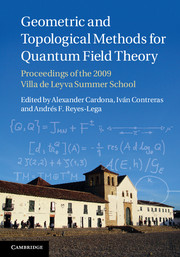 Geometric and Topological Methods for Quantum Field Theory
Geometric and Topological Methods for Quantum Field Theory Book contents
- Frontmatter
- Contents
- List of contributors
- Introduction
- 1 A brief introduction to Dirac manifolds
- 2 Differential geometry of holomorphic vector bundles on a curve
- 3 Paths towards an extension of Chern–Weil calculus to a class of infinite dimensional vector bundles
- 4 Introduction to Feynman integrals
- 5 Iterated integrals in quantum field theory
- 6 Geometric issues in quantum field theory and string theory
- 7 Geometric aspects of the Standard Model and the mysteries of matter
- 8 Absence of singular continuous spectrum for some geometric Laplacians
- 9 Models for formal groupoids
- 10 Elliptic PDEs and smoothness of weakly Einstein metrics of Hölder regularity
- 11 Regularized traces and the index formula for manifolds with boundary
- Index
- References
9 - Models for formal groupoids
Published online by Cambridge University Press: 05 May 2013
- Frontmatter
- Contents
- List of contributors
- Introduction
- 1 A brief introduction to Dirac manifolds
- 2 Differential geometry of holomorphic vector bundles on a curve
- 3 Paths towards an extension of Chern–Weil calculus to a class of infinite dimensional vector bundles
- 4 Introduction to Feynman integrals
- 5 Iterated integrals in quantum field theory
- 6 Geometric issues in quantum field theory and string theory
- 7 Geometric aspects of the Standard Model and the mysteries of matter
- 8 Absence of singular continuous spectrum for some geometric Laplacians
- 9 Models for formal groupoids
- 10 Elliptic PDEs and smoothness of weakly Einstein metrics of Hölder regularity
- 11 Regularized traces and the index formula for manifolds with boundary
- Index
- References
Summary
Abstract
This chapter is a brief overview of some semiclassical objects with particular relevance in Poisson geometry and deformation quantization: formal groupoids. We give a categorical description of the object, study its associated algebraic structure (Hopf algebroid), mentioning its relevance in Poisson geometry as formal realizations of Poisson manifolds.
Motivation and plan
The relation between smooth manifolds and their algebras of smooth functions has been studied deeply and the problem of connecting geometric information and algebraic data appears frequently in Lie theory and deformation theory, among others.
In particular, the notion of a groupoid appears naturally as a generalization of the structure of a group and it helps to understand geometric spaces. Its study in differential geometry allows us to link, for example, Lie groupoids and foliations of Poisson manifolds. In a more general setting, the notion of a groupoid object in a category C[1] can be introduced, and this generalized version of groupoid appears as a solution of what is called the Integrability problem or the generalized Lie Third Theorem for Lie algebroids [5] and in particular for Poisson manifolds [6], [4]. The main objective in this overview is to discuss different approaches to describe formal groupoids, which can be defined categorically as a groupoid object in a certain category, in which the properties of the object are encoded in the spaces of infinite jets associated to smooth manifolds.
- Type
- Chapter
- Information
- Geometric and Topological Methods for Quantum Field TheoryProceedings of the 2009 Villa de Leyva Summer School, pp. 322 - 339Publisher: Cambridge University PressPrint publication year: 2013


